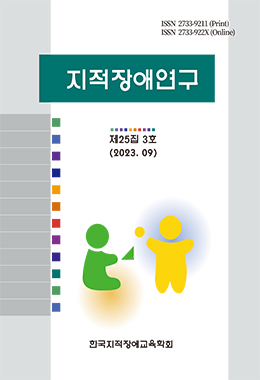연구목적: 이 연구에서는 새로운 시각지원 전략 중 하나인 유관매핑과 대표적인 연구기반 행동 중재 전략 중 하나인 토큰경제를 결합한 중재가 지적장애 학생의 수업참여행동에 미치는 효과에 대해 알아보고자 하였다. 연구방법: 연구의 대상은 만 13세의 지적장애 학생 1명으로 실험설계는 기준변동설계(Changing Criterion Design)를 변형한 ‘범위제한 기준변동설계(Range-Bound Changing Criterion Design)’를 사용하였다. 중재는 지적장애 특수학교 교실에서 연구자가 실시하였고, 실험은 기초선 중재 유지의 세 단계에서 연구 대상자의 수업참여행동을 측정하였다. 수집된 자료는 평균(average), 범위(range), 준수비율(PCD: Percentage of Conforming Data), 절대적 수준변화(Between conditions absolute level change), 상대적 수준 변화(Between conditions relative level change), 비중복비율(PND: Percentage of Nonoverlapping Data points)과 개선율 차이(IRD: Improvement Rate Difference)를 사용하여 분석하였다. 연구결과: 연구결과 중재 전체 구간에서의 PCD는 모두 100%로 나타났다. 완전 반전 및 미니반전을 제외한 중재 전체 구간에서의 PND, IRD 또한 모두 100%로 나타났다. 기초선을 제외한 모든 실험조건에서의 절대적 수준변화는 +1~+9, 상대적 수준변화는 +1.5~+8 로 나타났다. 그리고 미니반전과 완전반전 조건에서는 명확한 반전 결과가 나타났다. 결론: 이러한 결과는 유관매핑과 토큰경제를 이용한 중재가 지적장애 학생의 수업참여행동 증진에 효과적인 중재가 될 수 있음을 시사한다. 이상의 결과를 바탕으로 유관매핑과 범위제한 기준변동 설계에 대한 논의를 전개하였다.
Purpose: The purpose of this study was to investigate the effect of intervention that combines Continuity mapping and Token economy on the class participation behavior of students with intellectual disabilities. Method: The subject of the study was a 13-year-old student with intellectual disability, and the experimental design used the 'Range-Bound Changing Criterion Design', which is a modification of the Changing Criterion Design. The intervention was conducted by the researcher in the classroom of a special school for intellectual disabilities, and the experiment measured the subject's class participation behavior in three stages of baseline, intervention and maintenance. The data was analyzed by means of average, range, between absolute level change, between conditions relative level change, and percentage of conforming data(PCD), Percentage of Nonoverlapping Data points(PND), Improvement Rate Difference(IRD). Result: As a result of the study, PCD in the entire intervention period was 100%. PND and IRD in the entire intervention period, excluding full reversal and mini reversal, were also 100%. The absolute level change in all experimental conditions except the basicline was +1 to +9, and the relative level change was +1.5 to +8. And in the conditions of mini-reversal and full-reversal, clear reversal results appeared. Conclusion: These results suggest that interventions using contingency mapping and token economy can be effective interventions to improve class participation behavior of students with intellectual disabilities. Based on the above results, discussions and future researches were suggested.




